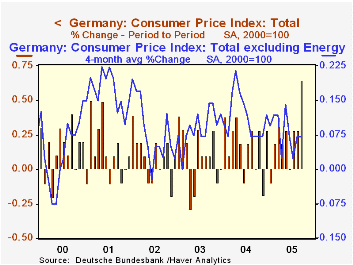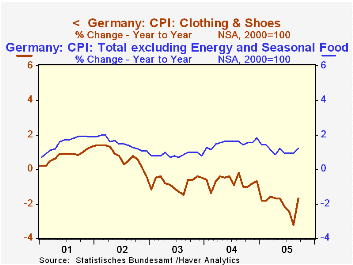 Global| Oct 12 2005
Global| Oct 12 2005German Inflation 2.5% in September; Erratic Moves in Clothing and Food Add to Push from Energy
Summary
Year-on-year inflation in Germany surged last month to 2.5%, up from 1.9% in August and the strongest since the spring of 2001. Energy was mainly responsible, accelerating to 15.9% from 11.6% in August. But other prices firmed in [...]

Year-on-year inflation in Germany surged last month to 2.5%, up from 1.9% in August and the strongest since the spring of 2001. Energy was mainly responsible, accelerating to 15.9% from 11.6% in August. But other prices firmed in September as well, as the total CPI excluding energy picked up to 1.2% from 0.9%.
As seen in the table below, food items are partially responsible for the general rise in non-energy inflation. More particularly, fruits and vegetables increased more in September; these are "seasonal" items and the Federal Statistical Office calculates a sub-index of seasonal foods. Not seasonally adjusted, this index rose 3.3% from September 2004, after just 0.9% in August and 0.2% in July. But non-seasonal food, non-energy items also increased more, 1.2% versus 0.9%. A main mover in this subset was clothing. As in many countries, clothing and textile prices have been falling in Germany, and in September, they fell "only" 1.7%, compared with 3.2% in August. However, as illustrated in the second graph, rather than marking some underlying resurgence in clothing prices, this latest move seems mainly to offset the extremely weak performance of the prior few months; it is still weak compared with 2004 and 2003.
Clearly, "one month does not make a trend", so it's too soon to judge that the September advance in Germany's CPI marks a shift toward higher inflation. For the time being, we can "explain it away" using several discounting factors: concentrated and erratic changes in clothing prices and a seasonal rise in seasonal food. As expensive energy weighs more and more on all the world's economies, it remains to be seen if these selective bursts of inflation will continue to be "selective" and what implications they will have for the real side of the economy.
| German CPI % changes* |
Sept 2005 | Year Ago | Aug 2005 | Year Ago | December/December|||
|---|---|---|---|---|---|---|---|
| 2004 | 2003 | 2002 | |||||
| Total | 0.6 | 2.5 | 0.3 | 1.9 | 2.1 | 1.2 | 1.1 |
| Total ex Energy | 0.4 | 1.2 | 0.1 | 0.9 | 1.6 | 1.2 | 0.7 |
| Food | 0.1 | 0.5 | 0.4 | 0.0 | -0.4 | 1.6 | -1.1 |
Carol Stone, CBE
AuthorMore in Author Profile »Carol Stone, CBE came to Haver Analytics in 2003 following more than 35 years as a financial market economist at major Wall Street financial institutions, most especially Merrill Lynch and Nomura Securities. She had broad experience in analysis and forecasting of flow-of-funds accounts, the federal budget and Federal Reserve operations. At Nomura Securities, among other duties, she developed various indicator forecasting tools and edited a daily global publication produced in London and New York for readers in Tokyo. At Haver Analytics, Carol was a member of the Research Department, aiding database managers with research and documentation efforts, as well as posting commentary on select economic reports. In addition, she conducted Ways-of-the-World, a blog on economic issues for an Episcopal-Church-affiliated website, The Geranium Farm. During her career, Carol served as an officer of the Money Marketeers and the Downtown Economists Club. She had a PhD from NYU's Stern School of Business. She lived in Brooklyn, New York, and had a weekend home on Long Island.





